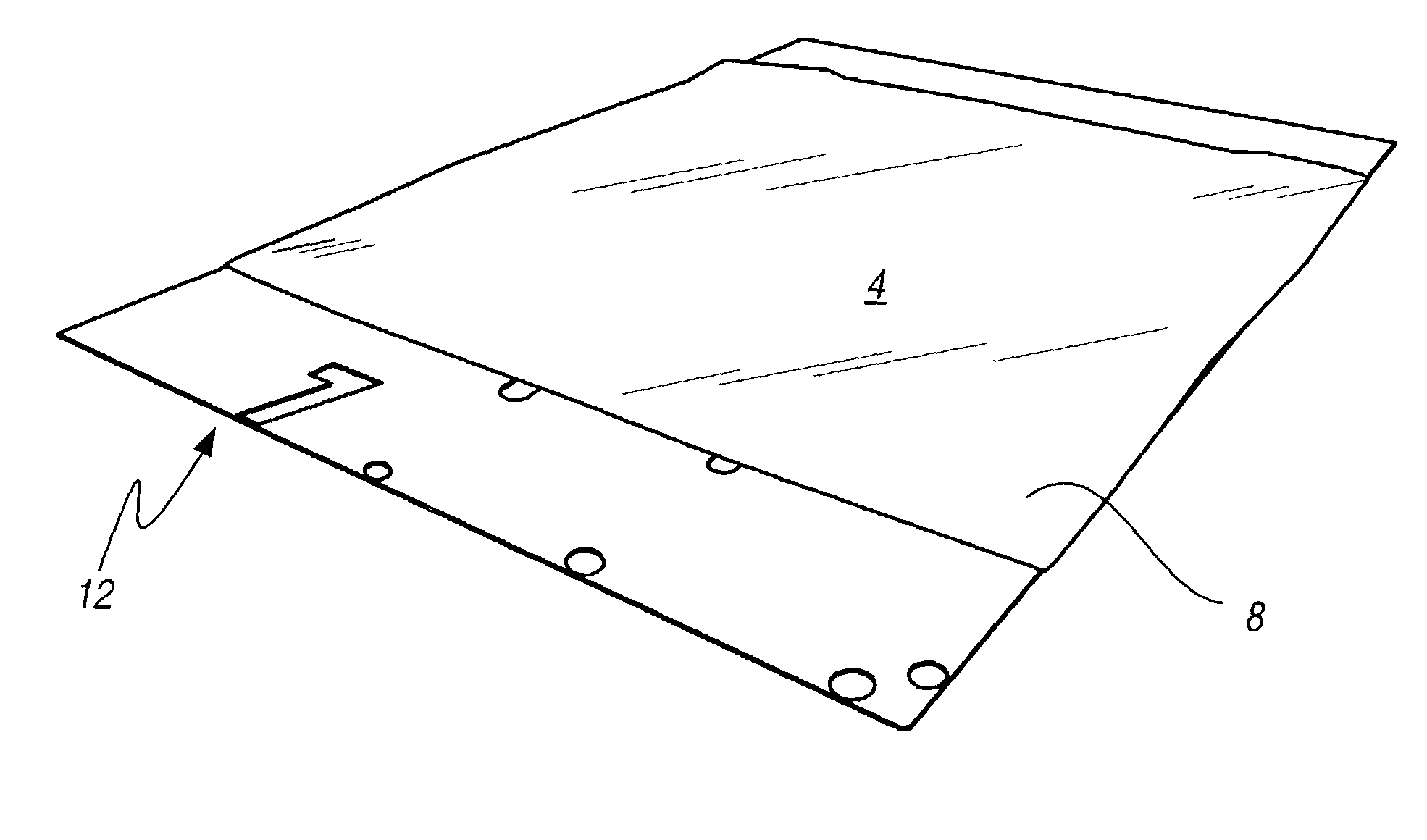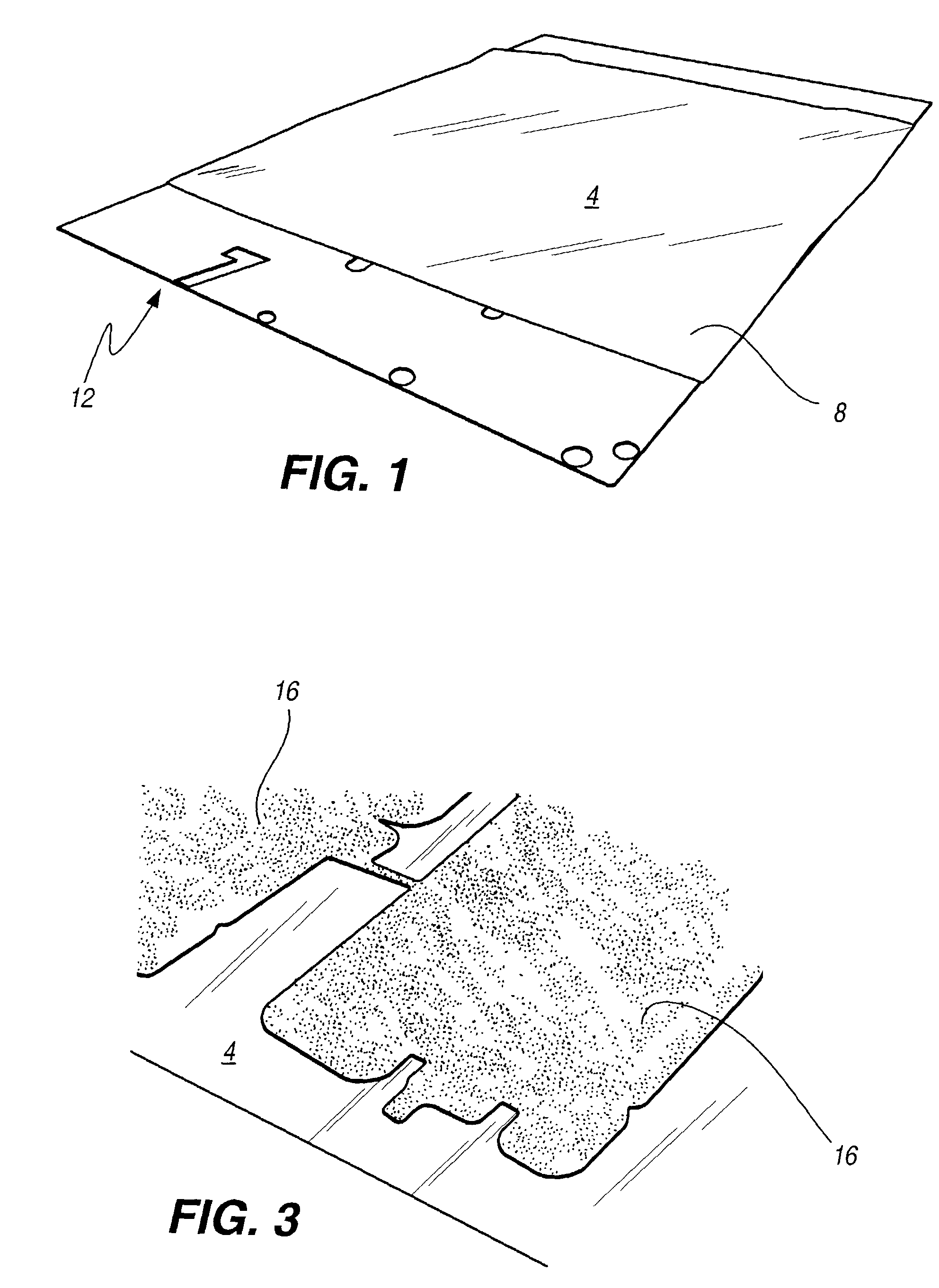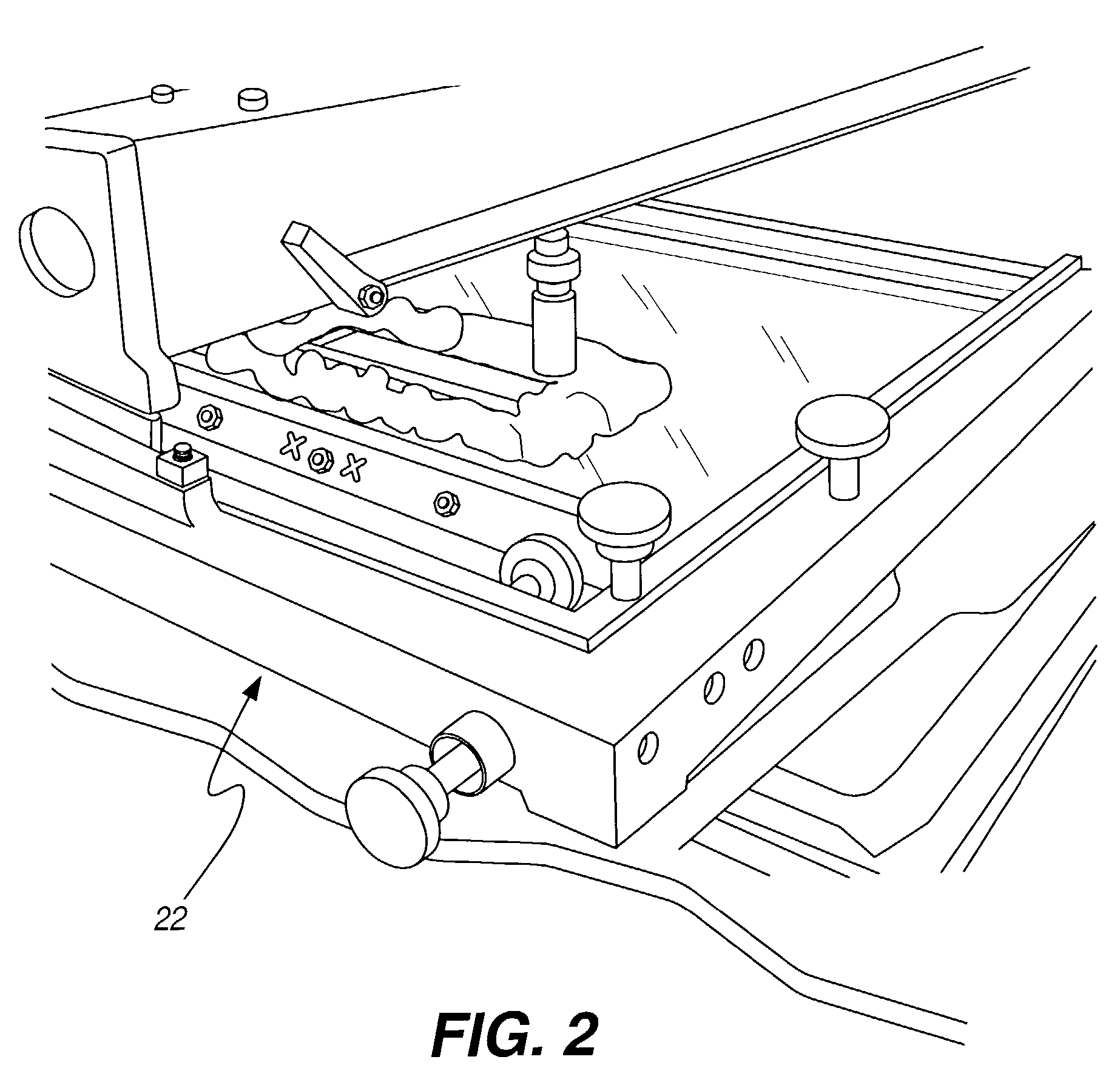[0014]As will be appreciated, an “adhesive” is any substance, whether inorganic or organic, natural or synthetic, that is capable of bonding other substances together, typically by surface attachment. Examples of suitable adhesives include high temperature adhesives, such as polybenzimidazoles and silica-
boric acid mixtures or cements, hot-melt adhesives, thermoset adhesives, and
polyurethane. Particularly preferred adhesives are in the form of resin dispersions such as
plastisol. “Hot-melt adhesives” generally refer to a
solid,
thermoplastic material that forms a melt bond upon heating and subsequent cooling, “thermoset adhesives” generally refer to a
high polymer that solidifies or “sets” irreversibly when heated, and “resin dispersions” generally refer to a
solid phase of particles of one or more resins dispersed in a continuous, typically liquid, phase (e.g., a
plasticizer). The resin dispersion gels and / or fuses when heated. The resin dispersion can be water-based or
solvent-based and in the form of a liquid or paste or in the form of a
solid mixture of a resin and
plasticizer. The “gelled phase” refers to a semi-solid phase, such as a viscous jelly-like product, or solid phase of an organic material that has little or no cross-linking while the “fused” stage refers to a solid phase in which at least most, if not all, of the polymers in the resin particles are cross-linked.
Plastisol is a type of resin dispersion and is a dispersion of one or more resins in a
plasticizer.
Plastisol is in the form of a liquid or paste. The resin component preferably is an organic, crosslinkable
polymer or
oligomer that, when converted to its final state for use, is crosslinked, and, after being crosslinked, is
high frequency weldable. Preferred resins include poly (
ethylene vinyl acetate), poly (
vinyl chloride), polyamides and polyurethanes, and more preferably are a
polymer or
oligomer of a vinyl
monomer, such as
polyvinyl chloride. The resin dispersion can include fine particles of polymers or copolymers, as well as one or more of plasticizer(s),
viscosity reducer(s),
viscosity increaser(s), stabilizer(s), filler(s), thickener(s), curing agent(s) (such as an
isocyanate),
pigment(s), etc. Typically, the plasticizer is the continuous phase in the resin dispersion and acts as a vehicle for the dispersed resin and other additives. The resin acts as a binder for all of the other additives. The
pigment, if any, determines the color and
opacity of the resin film. The filler increases the
viscosity and / or thickness of the resin dispersion film, as applied, proportionally with the concentration of the filler. The stabilizer, used when
pigment is added, prevents discoloration of the resin film. The viscosity
reducer effectively reduces the viscosity of the resin dispersion, which can be important in
screen printing deposition methods. The viscosity increaser increases the viscosity of the resin dispersion. Preferably, at least some of the volume of the continuous
liquid phase comprises one or more liquid plasticizers.
[0024]As will be appreciated, the bonding force between the resin dispersion and the decorative medium is greater than the bonding force between the release adhesive and the resin dispersion to permit the carrier to be removed and so the finished product is durable.
[0041]The various processes and transfers can have a number of advantages. First, multicolored free-form images or designs can be manufactured inexpensively and in high volumes. Second, the process can be relatively simple and require at most a modest
capital investment. Third, the precision of
screen printing permits adhesive to be applied such that portions of the design are easily omitted so as to be free from
cutting or trimming operations. The ability to create voids in the finished design where desired not only eliminates subsequent
cutting and / or picking out of material to be eliminated (like the center of the letter “O”) but also saves material and money. This is especially desirable where the design has multiple disconnected parts. This ability also permits novel design configurations, such as designs where the resin film or substrate is exposed as part of the overall design. Alternatively, part of the resin dispersion can be left exposed and the dispersion then sprinkled with or dipped into a design medium to fill the exposed area of the resin dispersion. The exposed area can thus be used for inclusion of different types of design medium materials (like textiles, holograms,
glitter particles, beads, etc.) incorporated into the finished product to create interesting, mixed media looks. Fourth, an adhesive
powder is not required to be placed on the side of the design to be bonded to the substrate. Fifth, the free-form image produced by the process can be much softer and have richer coloration than free-form images produced by other processes, such as those using inks for coloration. The amenability of the process to a multicolor direct flocking process permits the creation of multicolor flocked images. Sixth, the free-form image can have a sufficient tensile strength for handling independently of any carrier or substrate. Seventh, the process uses a resin dispersion, rather than a resin film plus a
thermoplastic (
hot melt) adhesive, such as
polyester, during
screen printing. This eliminates cost, time, and many problems associated with
drying, removing excess material, and curing adhesives. A resin film will be a more homogenized and less expensive finished product. Eighth, the process does not require (in addition to the primary carrier) a base layer to support the resin film. Various embodiments of the present invention apply (such as by screen printing techniques) the resin dispersion directly to (and form the resin film from the resin dispersion in) only one or more discrete portions of the primary carrier that are typically in the pattern of or the reverse pattern of the design, depending upon the
process configuration. When the resin dispersion is applied and fused with
high frequency energy or welded, there is preferably no
polyester, plastic, or other type of polymeric film (such as a poly(
vinyl chloride) film) already in place on the carrier. Rather, the resin dispersion is applied directly to the release adhesive on the carrier. Ninth, the fused resin formed from the resin dispersion is weldable to substrates, such as textiles, using
high frequency energy.
 Login to View More
Login to View More 


